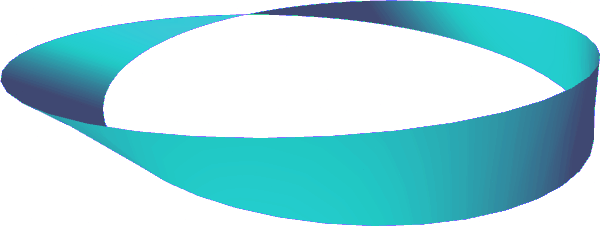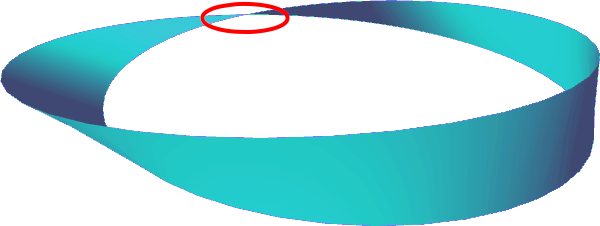Fiber Bundles and Čech cohomology
An analysis of the Möbius band
The Möbius band is a simple example of a nontrivial vector bundle (or more generally, a fiber bundle.)

If anyone was asked to describe what is special about the Möbius band, they would point out the single twist.

Indeed that is what characterizes the Möbius band, as nothing else happens; and yet mathematically we’d also have to point out that the rest is boring, as “a twist” is not a full description (of course in regular communication it implies that the rest is “as-is”, i.e. without a twist.)

The description of the Möbius band we arrive at says that on one area, there’s a twist, and on the other area, there’s no twist. How large should the circled areas be? It is obvious that making these areas a bit smaller or larger would not affect our description. How wide should the Möbius band be? It is again obvious that making the band narrower would not affect its character. By taking these ideas to their limit, we arrive at this distilled description of the Möbius band:
The boring part is labeled $1$ while the twist is $-1$. We cannot reduce the description further. The meaning of $1$ and $-1$ comes from the description of the transition maps for a 1-dimensional vector bundle, namely they are elements of the general linear group $\operatorname{GL}(1, \mathbb{R})$ which is group-isomorphic to the multiplicative group $\mathbb{R}\setminus 0$. If we name the two circled areas of the Möbius band as $V$ and $W$, then we have maps $V, W\to\operatorname{GL}(1,\mathbb{R})$. Just as we reduce $V$ and $W$ to points their images also reduce to values on $\operatorname{GL}(1,\mathbb{R})$, and it is immaterial to which as long as the component is respected; obviously $\operatorname{GL}(1,\mathbb{R})$ has two distinct components.
What is this distillation process?
If we repeat the analysis of the Möbius band for the trivial bundle $S^1\times\mathbb{R}$ (a cylinder), we will end up with $S^1$ and a single point with the value $1$.
Can we reverse this process to obtain the original bundles from their limit pictures? The Fiber Bundle Construction Theorem tells us that we can construct fiber bundles from the transition maps $U_i\cap U_j \to G$ for an open cover $U_i$ of the base. This is very close to what we had just before taking limits in the Möbius band; the areas $V$ and $W$ are the intersections of the cover $U_1, U_2$ of $S^1$.
This already gives us intuition for the Fiber Bundle Construction theorem, but there is another connection we can make! The maps $U_i\cap U_j \to G$ also describe a $G$-valued Čech 1-chain (in fact a 1-cocycle.) The limit description of the Möbius band is nothing but an element of the first Čech cohomology group $\check{H}^1(S^1; \operatorname{GL}(1, \mathbb{R}))$.
More generally, we have an identification of fiber bundles $F \to X$ with structure group $G$ and elements of $\check{H}^1(B; G)$, see the notes below for a reference.
Yet another limit
This paragraph is entirely parenthetical, since our main goal was to point out this equivalence between fiber bundles and the first Čech cohomology group.
It is possible to take yet another limit; so far we’ve only shrunk down the fibers, but conceivably the base space $X$ could also be shrunk. For instance, had the base space $S^1$ been widened to $S^1\times(-1,1)$ for example, the 1-dimensional vector bundle $(S^1\times(-1,1))\times\mathbb{R}$ to be distilled to the same picture as the cylinder. On a Mathematical level, since we established a construction of fiber bundles via $\check{H}^1(X; G)$, we are simply leveraging the fact that cohomology is preserved for homotopy-equivalent spaces $X$ and $X’$.
In fact $\check{H}^1(X; G)$ is equivalent the the homotopy classes $[X, BG]$ where $BG$ is the classifying space of $G$; this is yet another way to visualize what’s going on: instead of focusing on the transition maps, think of the fibers themselves: for vector bundles it is obvious that a mapping $X \to \operatorname{Gr}(k, n)$ represents a $k$-subbundle of (say) $X\times\mathbb{R}^n$, and by distilling this map homotopically we end up with an element of $[X, BO(k)]$.
Notes
- There is a wonderful post by Zhen Lin on stackexchange which explains the isomorphisms for Čech cohomology and fiber bundle constructions, https://math.stackexchange.com/a/197989.
- The reader should be warned that Čech cohomology is not typically discussed for nonabelian groups, because it does not go beyond the first cohomology group (as we’ve seen, it completely classifies the fiber bundle space.) Čech cohomology is almost always in the context of abelian groups.
- The Möbius band was created using sage’s
sage.plot.plot3d.parametric_surface.MoebiusStrip, color corrected with GIMP, and cropped via ImageMagick. The limit process pictures were created in Inkscape.

